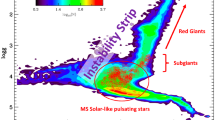Abstract
Masses of 19 asteroids have been determined from the analysis of their gravitational effect on the motion of perturbed bodies. The following asteroids were selected as perturbed bodies: (1) those which had single close encounters with the perturbing asteroid; (2) those whose mean motion was in a 1 : 1 commensurability with that of the perturber and which had close or moderate recurrent encounters with the perturber. The perturber mass was determined from observations of several tens of perturbed asteroids that were selected from these two groups. The selection criterion was the error of the mass determined from observations of only one asteroid. Positional observations of the asteroids on the interval 1900–2002 were used. The masses were determined with errors by an order-half an order of magnitude smaller than the masses found. The results are compared with those of other authors.
Similar content being viewed by others
REFERENCES
Herget, P., Outer Satellites of Jupiter,Astron. J., 1968, vol. 73,no. 8, pp. 737-742.
Hilton, J.L., Seidelman, P.K., and Middour, J., Prospects for Determining Asteroid Masses,Astron. J., 1996, vol. 112,no. 5, pp. 2319-2329.
Hilton, J.L., Asteroid Masses and Densities,Asteroids III, Bottke, W., Cellino, A., Paolicchi, P., and Binzel, R.P, Eds., Tucson: Univ. Arizona Press, 2003, pp. 103-112.
Hoffmann, M., Asteroid Mass Determination: Present Situation and Perspectives,Asteroids II, Binzel, R.P., Gehrels, T., and Matthews, M.S., Eds., Tucson: Univ. Arizona Press, 1989, pp. 228-239.
Kochetova, O., and Chernetenko, Yu., Determination of Mass of Jupiter and That of Some Minor Planets From Observations of Minor Planets Moving in 2: 1 Commensurability with Jupiter,Dynamics of Natural and Artificial Celestial Bodies, Pretka-Ziomek, H., Wnuk, E., Seidelmann, P.K., and Richardson, P., Eds., Dordrecht: Kluwer Acad., 2001, pp. 333-334.
Kochetova, O.M., The Influence of Motion Model and Observational Errors on the Accuracy of Determining Orbital Parameters of Minor Planets,Tr. IPA RAN, 2000, no. 5, pp. 197-203.
Krasinsky, G.A., Pitjeva, E.V., Vasilyev, M.V., and Yagudina, E.I., Estimating Masses of Asteroids,Soobshch. IPA RAN, 2001, no. 139.
Krasinsky, G.A., Pitjeva, E.V., Vasilyev, M.V., and Yagudina, E.I., Hidden Mass in the Asteroid Belt,Icarus, 2002, no. 158, pp. 98-105.
Kuznetsov, V.B., Catalog of Asteroid Encounters,Soobshch. IPA RAN, 2000, no. 136.
Kuznetsov, V.B., Determination of Masses of 108 Asteroids,Soobshch. IPA RAN, 2001, no. 138.
Lupishko, D.F., Shevchenko, V.G., and Tungalag, N., Influence of Scattering Law on the Asteroid Photocentre Position, inExtension and Connection of Reference Frames Using Ground Based CCD TechniquePinigin, G.I., Ed.,Proc. Int. Astron. Conf., Nikolaev (Ukraine), 2001, pp. 133-138.
Lupishko, D.F., Improved IRAS Albedos and Diameters of Asteroids,Astron. Vestn., 1998, vol. 32,no. 2, pp. 141-146 [Sol. Syst. Res.(Engl. Transl.), vol. 32, no. 2, p. 122].
Michalak, G., Determination of Asteroid Masses II. (6) Hebe, (10) Hygiea, (15) Eunomia, (52) Europa, (88) Thisbe, (444) Gyptis, (511) Davida, and (704) Interamnia,Astron. Astrophys., 2001, vol. 374, pp. 703-711.
Millis, R.L., Wasserman, O.G., Franz, N.M.,et al., The Diameter of 88 Thisbe From Its Occultation of SAO 187124,Astron. J., 1983, vol. 88,no. 2, pp. 229-235.
Shor, V.A., Ed.,Efemeridy malykh planet na 2003 god(Ephemerides of Minor Planets for 2003), St. Petersburg: IPA Ross. Akad. Nauk, 2002.
Standish, E.M., Newhall, X.X., Williams, J.G., and Folkner, W.F., JPL Planetary and Lunar Ephemerides, DE403/LE403,JPL Interoffice Memorandum, 1995, no. 314.10-127, pp. 1-22.
Tedesco, E.F., Asteroid Magnitudes, UBV Colors, and IRAS Albedos and Diameters,Asteroids II, Binzel, R.P., Gehrels, T., and Matthews, M.S., Eds., Tucson: Univ. Arizona Press, 1989, pp. 1090-1138.
Tedesco, E.F. and Veeder, G.I., IMPS Albedos and Diameters Catalog (FP102),The IRAS Planet Survey, Tedesco, E.F.,et al., Eds., Phillips Lab., 1992, pp. 243-285.
Tholen, D.J., Asteroid Taxonomic Classifications,Asteroids II, Binzel, R.P., Gehrels, T., and Matthews, M.S., Eds., Tucson: Univ. Arizona Press, 1989, pp. 1139-1150.
Yeomans, D.K., Barriot, J.-P., Dunham, D.W.,et al., Estimating the Mass of Asteroid 253 Mathilde From Tracking Data during the NEAR Flyby,Science, 1997, vol. 278, pp. 2106-2109.
Yeomans, D.K., Antreasian, P.G., Cheng, A.,et al., Estimating the Mass of Asteroid 433 Eros during NEAR Spacecraft Flyby,Science, 1999, vol. 285, pp. 560-561.
Author information
Authors and Affiliations
Rights and permissions
About this article
Cite this article
Kochetova, O.M. Determination of Large Asteroid Masses by the Dynamical Method. Solar System Research 38, 66–75 (2004). https://doi.org/10.1023/B:SOLS.0000015157.65020.84
Issue Date:
DOI: https://doi.org/10.1023/B:SOLS.0000015157.65020.84




